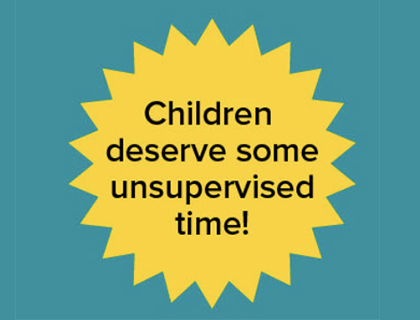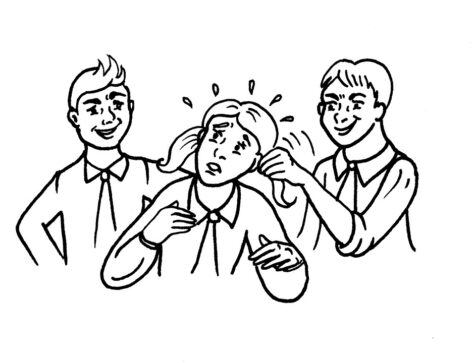If you’re over 35, you probably remember playing outside till the streetlights came on. But today, a lot of parents worry that if they let their kids play the old-fashioned way – spontaneously, unsupervised, with whoever’s available in the neighborhood — their children will be bullied by kids older than them.
Here are some ways for you to help them (and you!) put those fears in perspective:
1. Mixed-age play reduces bullying
Bullying is actually less common when kids play in mixed-age groups. Older kids often (imperfectly, of course) step into the caregiver role. It’s actually how they start to build empathy.
As my Let Grow co-founder Peter Gray noted on his Substack, Play Makes Us Human:
“In a review of cross-cultural anthropological studies of children’s social interactions, Beatrice Whiting (1983) concluded that boys and girls everywhere demonstrate more kindness and compassion toward children who are at least three years younger than themselves than they do toward children closer to their own age.”
2 A little discomfort is a good thing
No child will be happy every moment they’re playing. Good! Children need love, safety, and great experiences. That’s their sunshine. But they also need some confusion, anger, sadness, and fear. That’s their rain, and it helps them grow. Not a tsunami! Not a hurricane! A little rain.
3. Not all meanness is bullying
There will inevitably be spats when kids get together. I listen to kids playing outside during the summer and the phrase I hear most often is, “That’s not fair!”
But bullying is something different: Intentional and persistent harassment and/or intimidation.
4. Fight jerks with “social jiu-jitsu”
Since we will never be able to get rid of all bullies, what we can try to do is teach kids how not to be victims (per “bullying expert” Izzy Kalman). We know that kids cannot control other people’s actions. But teaching them to ignore or even respond cheerfully to jerks (when possible) can be empowering. So instead of, “Don’t call me a fatso! That’s not nice! Stop it!” a response like “OMG, I wish I looked like you! I see you eat a Twinkie every day at lunch and yet you are so buff! How do you do it?” throws the bully for a total loop.
He has nothing to push on now. Learning that sort of “social jiu-jitsu” can change a kid’s whole life! (It works with adults, too.)
Note that this doesn’t work with physical bullying, just verbal.
5: Teach The Three R’s
One of the best ways to keep kids safe is to teach them The Three R’s. This lesson will keep them safer than locking them inside, or supervising every interaction:
Recognize — No one can touch where your bathing suit covers.
Resist — If someone bothers you, fight, kick, scream, yell.
Report — to you. Tell your kid: “If someone hurts you or makes you do something you don’t want to do, tell me and I won’t be mad at you. Even if they make you promise not to tell me, Do tell me. Nothing bad will happen, I promise.” This takes away the greatest weapon the bully (or molester) has: secrecy.
6. Ask: What kind of childhood do you want for them?
Finally, have other parents to try to remember how much they loved playing as a kid.
Then ask: “Do you wish your mom was watching you the whole time? Do you wish she was in the tree house with you? Do you wish she was there when you were talking to your friends? Do you wish you were kept ‘safe’ by never having any unsupervised play time, so you’d never possibly deal with a bully?
“If so, then do the same for your kids. But if you think you got something out of your time with friends, outside, playing and dealing with the inevitable conflicts, why not give that same gift to your kids?”
And then…open the door.




3 Comments
My parents think kids don’t get bullied anymore, but bullying happens in every generation. I love that this a very real approach to bullying for our kids. None of my kids deal with this issue now but if it ever comes up, I am glad I read this first. Thank you so much for this post!
It’s interesting that the advice we were given when I was a kid in the ’50s and ’60s, to fight back, is absent. Probably a good idea, since today the authorities will more likely punish the kid who defends himself instead of the bully. And besides, it wasn’t always effective. The common wisdom we got was that bullies are kids with low self-esteem, cowards who will always cave if you physically resist them. Well, sometimes. But sometimes they’re kids with way too much self-esteem, and if you hit back you’ll just piss them off and they’ll beat the crap out of you.
Inspiringly wise, by/large. A key for me was not to get baited or hung up by macho stuff. And while this may be a high wire act, something close to mocking can sometimes help. Is that what it takes to feel good about yourself? Maybe just walk away making clear (or not?) you don’t have time for such time-wasting nonsense. “Fighting back” can take the form of pointedly asking: Is that how you want to be treated? Or some such? I believe kids begin to learn empathy when nursing. Glad you’ve heroically made progress w/ 6. My efforts have elicited similar answers. But they fall back to the helicoptering peer pressure, rationalizing sheepishly it was a different time. Or so I gather. No one will convince me I should not have intervened to protect a pet from bullying. They got plenty of opportunity to fend for themselves when I wasn’t there.